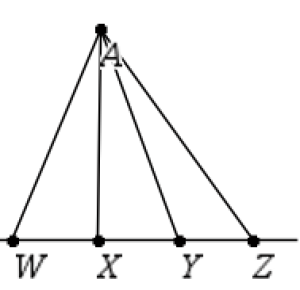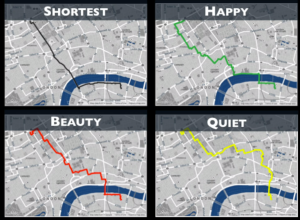In mathematics (or at least in Euclidean geometry), we define the distance from a point to a line as the length of the segment perpendicular from the segment to the line.
How often does our journey from one point to another coincide with the shortest path – “as the crow files” or “in a beeline”?
How often does saving a minute prevent us from experiencing what is beautiful?
How do we provide opportunities for our students to experience the mathematics we want them to learn instead of just giving them the most direct path to get to an answer?
My weekly TED.com email led me to Daniele Quercia’s talk of the week on Happy maps. I’m honestly not a “video person”. In fact, video often represents to me the shortest path while reading represents the beautiful path. But this video is 7:20 minutes, and I’m home all day on this cold Saturday taking a break from the book I’m reading, and so I clicked on it to watch. The blurb also caught my eye, since I blog about my classroom at Easing the Hurry Syndrome: Mapping apps help us find the fastest route to where we’re going. But what if we’d rather wander? Researcher Daniele Quercia demos “happy maps” that take into account not only the route you want to take, but how you want to feel along the way.
Quercia and his team incorporate human emotion with cartography. By adding a few minutes to travel time, we can experience the most enjoyable route to our destination instead of “the single path” that is the fastest.
How many of our students would choose a beautiful path over the shortest path to learn a new topic? Which of our students would always choose the shortest path over a happier path to learn a new topic?
Einstein (or someone else) said: “Logic will get you from A to B. Imagination will take you everywhere.”
What opportunities do we allow our students to use their imagination in mathematics, coupled with the logic that drives our subject? How often would our students say that they get to be creative in their approaches to the tasks we give them?
You’ve probably heard of the Slow Food movement and hopefully enjoyed more than one meal with friends and family paying attention to not only your conversation at the table but the food on your table and from where it came. Or maybe you’ve participated in other “slowing down” movements. My husband was awarded a Lilly Endowment Clergy Renewal Program grant several years ago to think about what Slow Church has to do with Slow Food.
What can you and your students do this upcoming week for the Slow Math Movement?


I love this idea. I’d be more likely to participate here if there were no ads. Math circles are a great way to get involved in ‘slow math’.
Thanks, Sue. I’ve heard some about math circles, but I have not participated in one. That does sound like a good place to engage in slowing down with colleagues.
Well said. So often I’m trying to get my students to the answer along the shortest path. I’m going to blame this on the amount of material I HAVE to cover due to state testing. This analogy that you have provides helps me to see how important and necessary it is to slow down.
Hi, Nora. I think most of us have this same problem. I am learning to slow down, but that in itself takes time. Hopefully we can all find a lesson in which to incorporate slowing down this week.
This strongly reminds me of the “you let me think” story from :
Tracy Zager.
Also, the discussion of a place for “math that isn’t hard” at Kassia Omohundro Wedekind’s blog.
This seems an area where it is easier as a parent than it would be for a classroom teacher. First, I don’t care about achieving some mandated curriculum target. Second, I don’t have to worry about keeping a large group together.
Thank you for both of your blog post suggestions. I read Tracy’s blog, but hadn’t come across Kassia’s before. Interesting comment about parents engaging in slow math with a child … lots to think about.